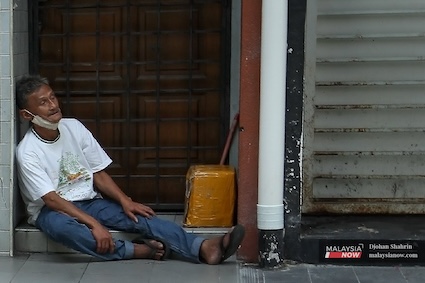Homeless in Kuala Lumpur – The forgotten issue

The homeless are becoming part of the scenery in KL now
MURRAY HUNTER
In the wake of the Covid-19 pandemic and the draconian measures employed in attempts to suppress the spread, the number of homeless in Kuala Lumpur has risen dramatically.
There is no recent data to base statistics from. A DBKL survey in 2016, estimated 1,500 homeless on the Kuala Lumpur streets. Observations around Kuala Lumpur indicate this number has risen drastically. The homeless have become the forgotten victims in society. These people are at the rock bottom of the B40 group.
The majority of homeless around Kuala Lumpur are locals, who are either estranged from their families, or don’t have families to go to. They are usually people who have been evicted from their accommodation, don’t have enough income to pay rent, have been unemployed for a long period of time, have huge debt, have disabilities or medical conditions like diabetes and hypertension that prevent their employment, have mental issues, had some form of falling out with their families, or been the victim of some major catastrophe. An increasing number of those over 60 are joining the homeless, as they have no savings. Some reports say this group may represent 40 percent of those homeless. There are also a number on the streets who have been victims of sexual abuse. The homeless are open to mosquitoes and the weather and thus vulnerable to many diseases, which need medication.
The homeless can be found around Chow Kit, Pudu, Medan Tuanku, Masjid Jamek, Bukit Bintang, Bangsar, Petaling Street, Mesjid India, LRT and MRT platforms, and KLCC areas. The homeless out on the streets live under pedestrian bridges, outside of empty shophouses. park benches, on sidewalks, or around office buildings that provide some protection against the weather. They use public facilities to wash and bath. Very few are beggars, but some scavenge rubbish to sell onto recyclers.
There is no single stereotype for the homeless in Kuala Lumpur. Each person has their own individual stories, which requires different solutions. Once people become homeless, they have almost insurmountable barriers to re-assimilating back into the community. Some don’t even have a bank account or have valid personal documents, which are needed for welfare assistance.
The ministry of Women, Family, and Community Development (MWFCD) is the authority responsible for the homeless. The Destitute Persons Act 1977 is grossly inadequate for the rehabilitation and reintroduction of the homeless into society. The Act is based upon the principal of vagrancy, rather than seeing the homeless as victims. Social workers work without the resources needed to help the homeless. In detention, they are not given sufficient medical attention to deal with their health issues.
Consequently, many are fearful of the authorities out of concern they will be forcible detained by DBKL or PDRM officers, who will cart them along to a magistrate, who may order them into involuntary detention under the Destitute Persons Act 1977. Any conviction under the Act criminalizes their homelessness, making it even more difficult to re-integrate back into society.
The government needs to review the current approach. The government must consider putting fully trained social workers on the front lines, with a flexible basket of resources behind them to tailor individual remedies for the problems of the homeless. Most assistance is left to NGOs, especially in the areas of providing food and temporary shelter. Safe environments enable the homeless to get a good night’s sleep, which they can’t get on the streets.
There also needs to be a strategic approach to homeless poverty with some form of universal welfare net, that will cover the homeless. This requires support with affordable housing for the homeless.
Otherwise, Kuala Lumpur will begin to look more like a number of US cities, where the destitute are seen everywhere throughout city centres. All Malaysians deserve assistance when they fall into trouble.

